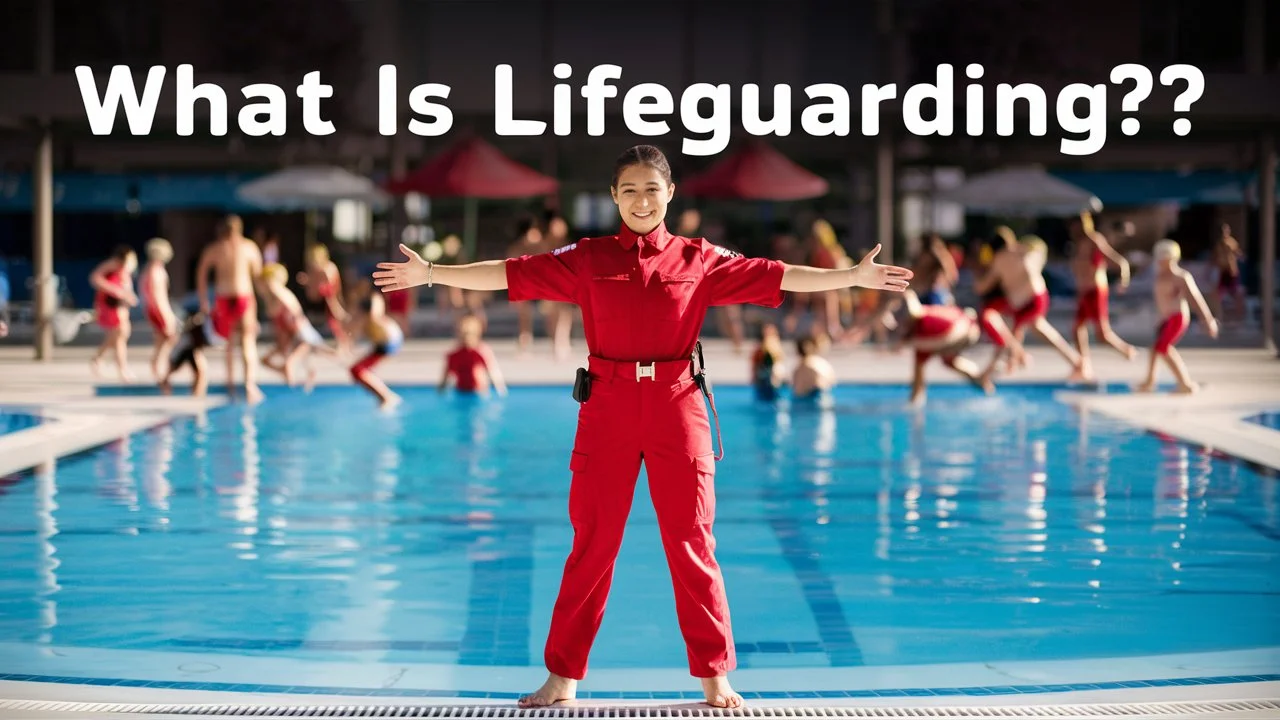“What is Lifeguarding?” Lifeguarding is more than just a summer job – it’s a critical role in ensuring water safety and preventing aquatic emergencies. This comprehensive guide explores the duties, skills, and qualifications required for lifeguards across various aquatic environments. Whether you’re considering a career in lifeguarding or simply curious about what it entails, this article will provide valuable insights into:
- The essential responsibilities of lifeguards
- Key skills and qualifications needed for the job
- Training processes and certification requirements
As we dive into the world of lifeguarding, you’ll discover why these professionals are vital to public safety and learn about the challenges and rewards of this important profession. From pool safety to beach rescues, lifeguards play a crucial role in making water-based activities enjoyable and secure for everyone.
History of Lifeguarding
The history of lifeguarding is as deep as the waters these professionals protect. Organized lifeguarding began in the 18th century, evolving from informal beach patrols to a recognized profession. In 1785, China’s first lifesaving organization was formed, marking an early step in formalizing water rescue.

The modern concept of lifeguarding took shape in the late 19th century. In 1891, the Royal Life Saving Society was established in England, focusing on drowning prevention and water rescue techniques. This sparked a global movement, with similar organizations forming worldwide.
Key developments in lifeguarding history include:
- 1910: Duke Kahanamoku, the “Father of Modern Surfing,” introduced the rescue board in Hawaii
- 1914: Commodore Wilbert E. Longfellow launched the American Red Cross Lifesaving program
- 1964: The first rescue tube was invented by Pete Peterson, revolutionizing water rescue methods
Lifeguarding techniques and equipment have continually evolved. Early lifeguards relied primarily on swimming skills and basic flotation devices. Today, they use advanced rescue equipment, communication tools, and surveillance technology.
Training has also advanced significantly. Early lifeguards learned through experience, while modern lifeguards undergo rigorous certification programs. These cover not only water rescue but also first aid, CPR, and emergency response protocols.
The profession continues to adapt to new challenges, including increasingly crowded beaches, extreme weather events, and changing aquatic environments. This ongoing evolution ensures that lifeguards remain at the forefront of water safety and emergency response.
Types of Lifeguarding Environments
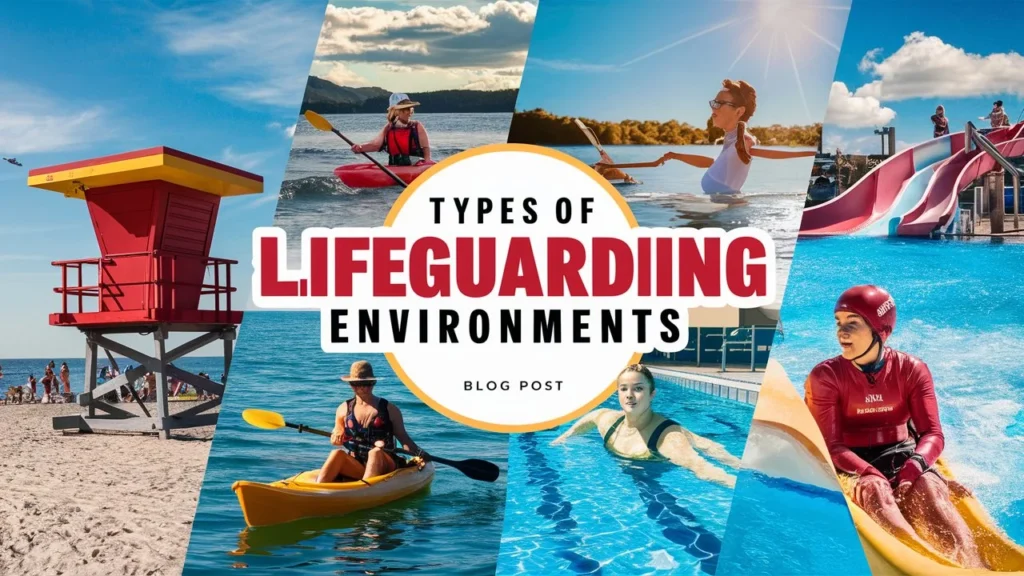
Lifeguards work in various aquatic settings, each presenting unique challenges and requiring specific skills. Understanding these environments is crucial for aspiring lifeguards and public safety.
Swimming Pools
Pool lifeguards monitor both indoor and outdoor facilities. They deal with controlled environments but face challenges like:
- High swimmer density, especially in public pools
- Monitoring different pool areas (deep end, shallow end, diving boards)
- Maintaining water quality and chemical balance
Beaches and Coastal Areas
Ocean lifeguards contend with dynamic conditions including:
- Changing tides and currents
- Rip currents and undertows
- Large crowds spread over wide areas
- Variable weather conditions
These guards often use specialized equipment like jet skis and patrol vehicles for surveillance and rescue operations.
Waterparks
Waterpark lifeguards oversee various attractions such as:
- Water slides
- Wave pools
- Lazy rivers
They must be alert to the specific risks of each attraction and manage high-volume crowds in a fast-paced environment.
Lakes and Rivers
Freshwater lifeguards face challenges like:
- Limited visibility in murky water
- Sudden depth changes
- Underwater hazards (rocks, branches)
- Unpredictable currents in rivers
Each environment requires tailored rescue techniques and safety protocols. Lifeguards often specialize in one area but may cross-train for versatility. Understanding these diverse settings helps lifeguards adapt their skills and stay prepared for any water safety scenario.
Primary Duties of a Lifeguard
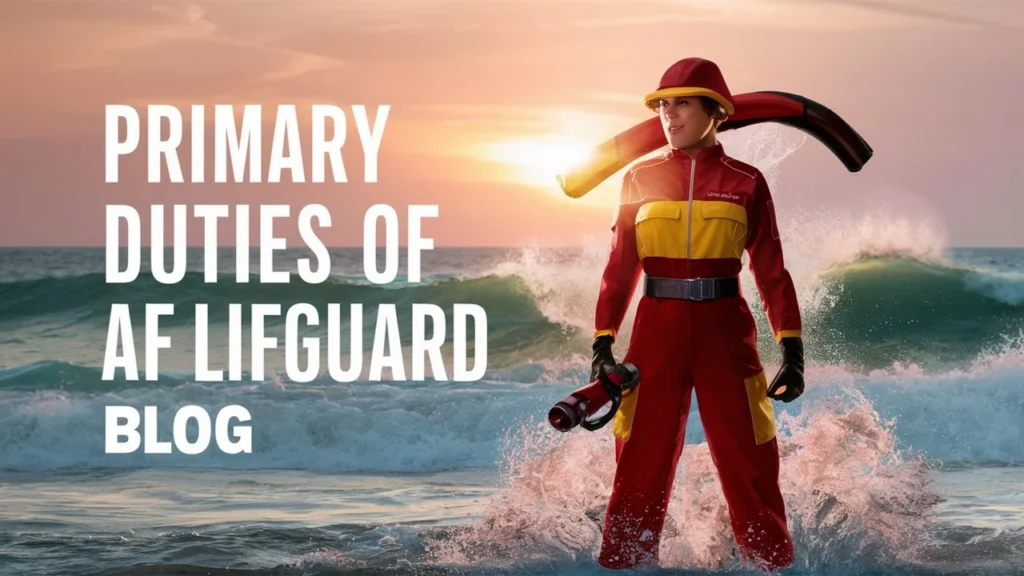
Lifeguards have a wide range of responsibilities that go beyond the popular image of whistle-blowing and dramatic rescues. Their primary duties focus on prevention, vigilance, and rapid response to emergencies.
Surveillance and Monitoring
The cornerstone of lifeguarding is constant vigilance. Lifeguards must:
- Scan their assigned area continuously
- Identify potential risks or hazards
- Watch for signs of distress among swimmers
This requires intense focus and the ability to maintain alertness during long shifts.
Prevention of Accidents
A key aspect of water safety is preventing emergencies before they occur. Lifeguards:
- Educate patrons about safety rules
- Intervene in dangerous behavior
- Assess and address potential hazards in the environment
Emergency Response and Rescue
When emergencies arise, lifeguards must act swiftly and decisively. This involves:
- Recognizing signs of drowning or distress
- Executing appropriate rescue techniques
- Coordinating with team members in complex rescues
First Aid and Medical Assistance
Lifeguards are often the first responders in medical emergencies. They must be proficient in:
- CPR and artificial respiration
- Basic first aid for injuries like cuts, sprains, or heat-related illnesses
- Using equipment like AEDs (Automated External Defibrillators)
Enforcing Safety Rules
Maintaining order and safety requires lifeguards to:
- Communicate rules clearly and firmly
- Handle conflicts with diplomacy
- Remove patrons who violate safety regulations
Maintaining Equipment and Facilities
Lifeguards also contribute to the upkeep of their workplace by:
- Inspecting and maintaining rescue equipment
- Reporting facility issues or damage
- Assisting with water quality tests in pool settings
These diverse duties require lifeguards to be multi-skilled professionals, combining physical abilities with strong communication and decision-making skills.
Essential Skills for Lifeguards
Effective lifeguarding requires a unique blend of physical and mental skills. These abilities are crucial for maintaining safety and responding to emergencies in aquatic environments.
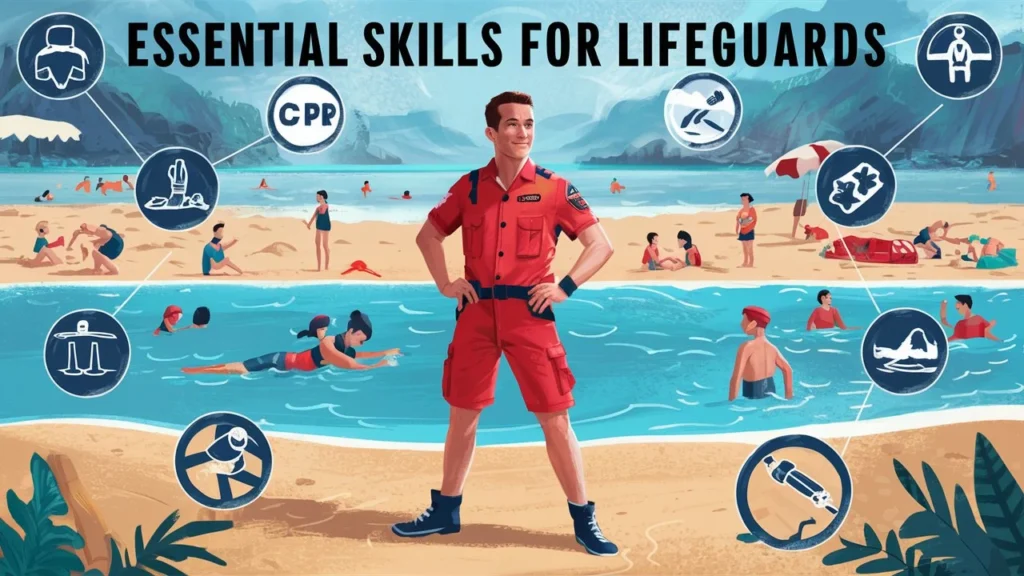
Swimming Proficiency
The foundation of lifeguarding is exceptional swimming ability. Lifeguards must:
- Maintain strong, efficient strokes in various conditions
- Swim long distances without fatigue
- Perform underwater maneuvers for rescues
Regular practice and conditioning are essential to maintain these skills.
Physical Fitness and Endurance
Lifeguarding is physically demanding. Guards need:
- Cardiovascular endurance for long shifts and rescues
- Strength for carrying victims and equipment
- Flexibility for quick movements and injury prevention
A consistent fitness routine is crucial for meeting these physical demands.
Alertness and Attention to Details
Vigilance is key in preventing accidents. Lifeguards must:
- Maintain focus during long periods of observation
- Quickly spot signs of distress or danger
- Notice subtle changes in swimmer behavior or water conditions
Developing strong observation skills and mental stamina is vital.
Decision-Making and Problem-Solving
Emergencies require rapid, sound decisions. Lifeguards should:
- Assess situations quickly and accurately
- Choose appropriate rescue methods
- Adapt to changing circumstances during a rescue
Regular training scenarios help hone these critical thinking skills.
Communication Skills
Clear communication is essential in lifeguarding. Guards must:
- Give clear instructions to swimmers and colleagues
- Use whistles and hand signals effectively
- Explain rules and safety procedures calmly and authoritatively
Practice in public speaking and conflict resolution can enhance these abilities.
Teamwork and Leadership
Many rescues require cooperation. Lifeguards should:
- Work effectively with other guards and emergency personnel
- Take charge in crisis situations when necessary
- Support and mentor junior team members
Developing these skills through team activities and leadership roles is beneficial.
By cultivating these essential skills, lifeguards can perform their duties effectively and confidently, ensuring the safety of all water users.
Qualifications and Certifications Becoming a Lifeguard
Becoming a lifeguard requires meeting specific qualifications and obtaining necessary certifications. These requirements ensure that lifeguards are prepared for the responsibilities of the job.
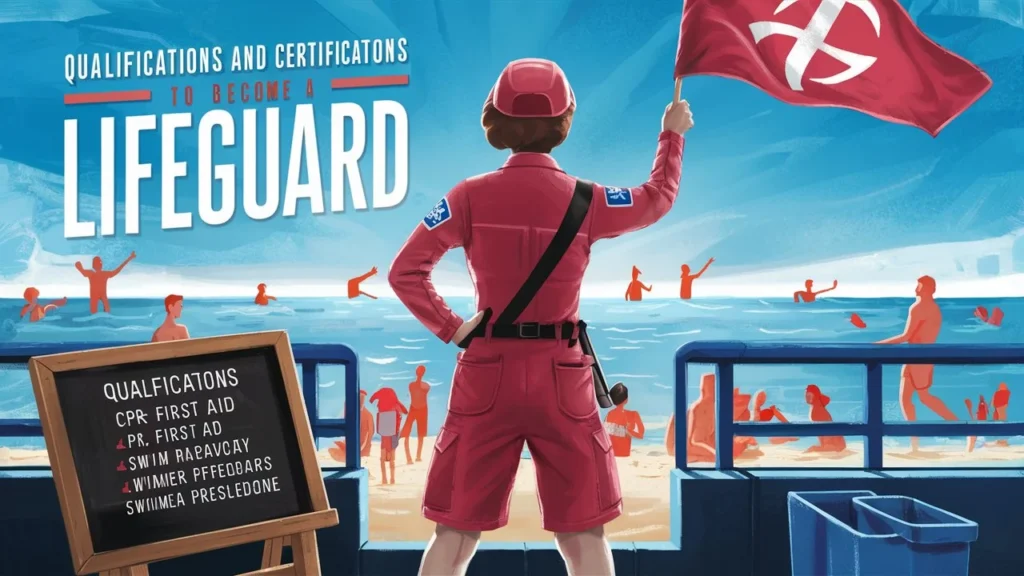
Age Requirements
Most lifeguarding positions have minimum age restrictions:
- Typically 15-16 years old for pool lifeguards
- Often 17-18 years old for beach or waterfront lifeguards
Specific age requirements may vary by employer or location.
Swimming Prerequisites
Before entering training, candidates must demonstrate strong swimming abilities:
- Swim 300-500 yards continuously using specified strokes
- Tread water for 2 minutes using only legs
- Complete a timed event retrieving an object from deep water
These tests ensure candidates have the basic skills needed for the job.
Lifeguard Training Courses
Formal training is mandatory and usually includes:
- Water rescue techniques
- Surveillance skills
- Emergency response procedures
- Spinal injury management
Courses typically last 20-30 hours and combine classroom and water-based training.
CPR and First Aid Certifications
All lifeguards must be certified in:
- Cardiopulmonary Resuscitation (CPR)
- Basic First Aid
- Automated External Defibrillator (AED) use
These skills are critical for responding to various emergencies.
Additional Specialized Certifications
Some positions require extra qualifications:
- Waterfront lifeguarding for beach or lake environments
- Waterpark lifeguarding for specific attraction types
- Scuba certifications for certain rescue scenarios
These specialized skills enhance a lifeguard’s versatility and job prospects.
Certification providers include organizations like the American Red Cross, YMCA, and Ellis & Associates. Most certifications require renewal every 1-2 years, ensuring lifeguards maintain up-to-date skills.
Meeting these qualifications and obtaining proper certifications is crucial for anyone aspiring to become a lifeguard. It demonstrates commitment to the profession and readiness to handle the responsibilities of ensuring water safety.
Overview of Lifeguard Training Programs
The lifeguard training process is comprehensive, designed to prepare candidates for the challenges of the job. It combines physical conditioning, theoretical knowledge, and practical skills.
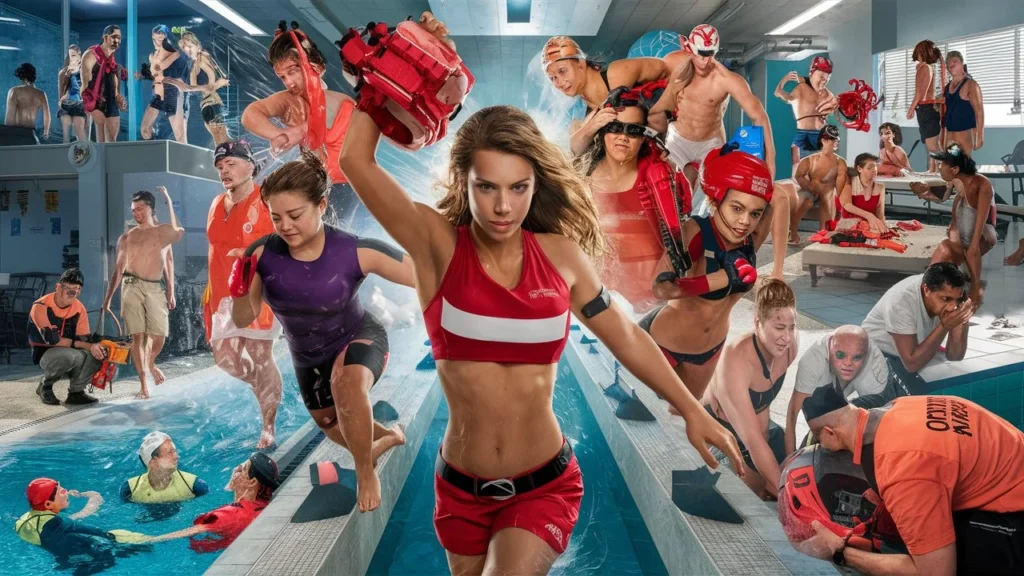
Training Programs
Training typically includes:
- 20-30 hours of instruction
- Mix of classroom and in-water sessions
- Final written and practical exams
Programs are offered by organizations like the American Red Cross and local aquatic facilities.
Physical Requirements and Tests
Candidates must pass rigorous physical assessments:
- Timed swims to test endurance
- Underwater object retrieval
- Treading water without using arms
These tests ensure lifeguards can perform rescues effectively.
Classroom Instruction
Theoretical knowledge covered includes:
- Drowning prevention strategies
- Risk management in aquatic settings
- Legal responsibilities of lifeguards
- Basic water chemistry for pool environments
Understanding these concepts is crucial for effective lifeguarding.
Practical Skills Training
Hands-on practice focuses on:
- Rescue techniques for various scenarios
- CPR and first aid application
- Use of rescue equipment (tubes, boards, AEDs)
- Entries and approaches to victims
Repetitive practice helps develop muscle memory for emergency situations.
Scenario-Based Learning
Trainees participate in simulated emergencies:
- Multiple-victim rescues
- Submerged victim retrieval
- Spinal injury management
- Dealing with uncooperative victims
These scenarios prepare lifeguards for real-world challenges.
Throughout the training, instructors assess candidates’ progress and readiness. Those who successfully complete all components receive certification, qualifying them for lifeguarding positions.
The training process is intensive but essential, equipping lifeguards with the skills and confidence needed to safeguard lives in aquatic environments.
Lifesaving Techniques and Equipment
Lifeguards rely on a variety of techniques and specialized equipment to perform rescues effectively. Mastering these tools and methods is crucial for ensuring swimmer safety.
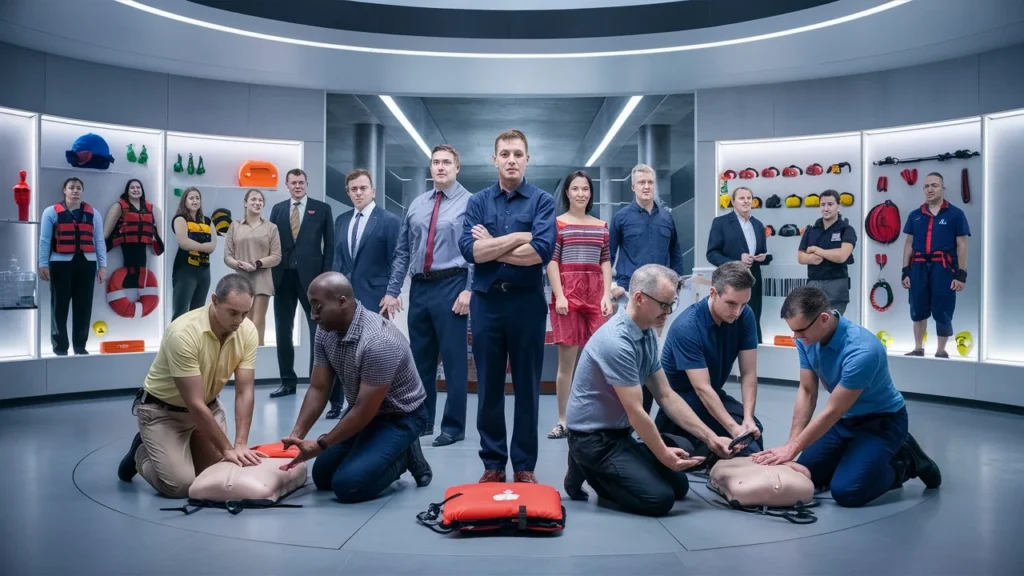
Rescue Methods
Lifeguards employ four main rescue approaches:
- Reaching: Using an extended object to help a nearby victim
- Throwing: Tossing a flotation device to a conscious swimmer
- Wading: Entering shallow water to assist a struggling swimmer
- Swimming: Performing a water rescue for distant or submerged victims
Each method is chosen based on the victim’s location and condition.
Use of Rescue Equipment
Essential tools for lifeguards include:
- Rescue tubes: Buoyant foam devices for water rescues
- Rescue boards: Larger floating platforms for multiple victims
- Ring buoys: Throwable devices for conscious swimmers
- Rescue cans: Hard plastic floats used in open water
Proper use of this equipment can significantly improve rescue outcomes.
Spinal Injury Management
Lifeguards must handle potential spinal injuries with care:
- Using backboards for in-water stabilization
- Performing careful extractions from the water
- Immobilizing the victim to prevent further injury
These techniques require precision and teamwork.
Cardiopulmonary Resuscitation (CPR)
CPR is a critical skill for lifeguards:
- Chest compressions to maintain blood flow
- Rescue breaths to provide oxygen
- Adapting techniques for different age groups
Regular practice ensures lifeguards can perform CPR effectively under pressure.
Automated External Defibrillator (AED) Use
AEDs are vital for cardiac emergencies:
- Quickly assessing heart rhythm
- Delivering shocks if needed
- Guiding rescuers through the resuscitation process
Familiarity with AED operation can be life-saving in critical situations.
Lifeguards must regularly practice these techniques and maintain their equipment to ensure they’re always ready for emergencies. Continuous training and drills help refine these skills, allowing lifeguards to respond swiftly and effectively when every second counts.
Challenges and Responsibilities
Lifeguarding comes with unique challenges and significant responsibilities. Understanding these aspects is crucial for those considering this career.
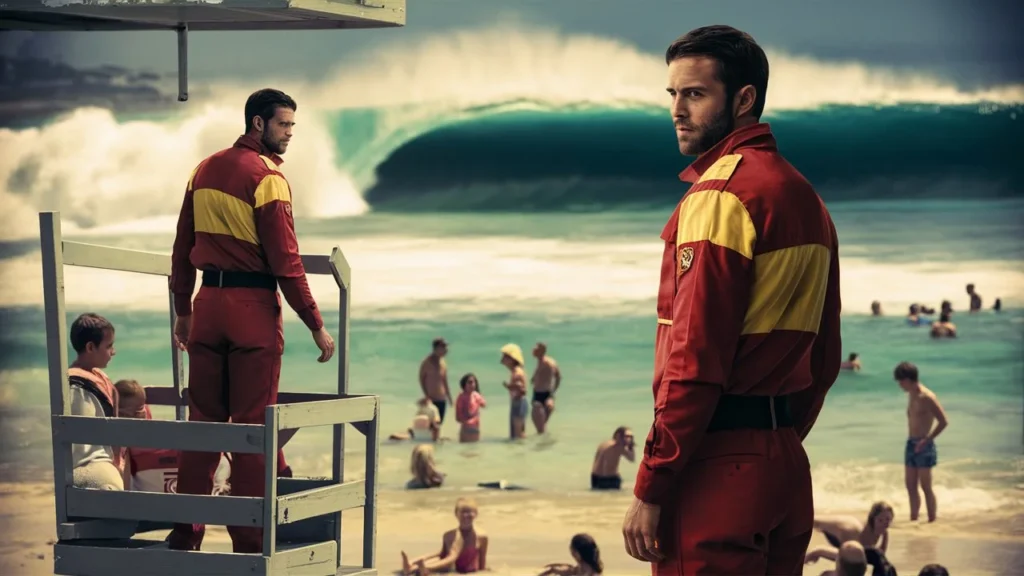
Dealing with Difficult Patrons
Lifeguards often face:
- Rule breakers and uncooperative swimmers
- Intoxicated individuals in aquatic settings
- Parents who neglect supervising their children
Developing strong communication and conflict resolution skills is essential.
Managing Large Crowds
Busy days present challenges like:
- Maintaining visibility of all areas
- Preventing overcrowding in certain zones
- Responding quickly to emergencies in dense crowds
Effective scanning techniques and teamwork are crucial in these situations.
Handling Emergencies Under Pressure
Lifeguards must:
- Remain calm during high-stress rescues
- Make quick decisions with limited information
- Coordinate with team members and emergency services
Regular drills and scenarios help prepare for these intense moments.
Maintaining Focus During Long Shifts
Challenges include:
- Staying alert during quiet periods
- Coping with extreme weather conditions
- Managing fatigue during long or irregular hours
Developing strong mental discipline and self-care habits is important.
Continuing Education and Skill Maintenance
Lifeguards are responsible for:
- Keeping certifications current
- Staying updated on new rescue techniques
- Participating in regular in-service training
Ongoing learning ensures lifeguards maintain peak performance.
These challenges require lifeguards to be physically fit, mentally resilient, and highly professional. The responsibility of safeguarding lives demands constant vigilance and readiness to act. While demanding, many find the role deeply rewarding, knowing their skills directly contribute to public safety.
Career Prospects and Advancement
Lifeguarding offers various career paths and opportunities for advancement. Understanding these prospects can help aspiring lifeguards plan their professional development.
Entry-Level Positions
Most start their careers as:
- Pool lifeguards at community centers or private clubs
- Beach lifeguards at coastal resorts or public beaches
- Waterpark lifeguards at amusement facilities
These roles provide essential experience and skill development.
Seasonal vs. Year-Round Opportunities
Lifeguarding jobs vary in duration:
- Summer positions at outdoor facilities
- Year-round roles at indoor pools or warm-climate beaches
- Part-time options for students or those with other commitments
Flexibility in scheduling is a benefit for many in this field.
Advancement to Senior Roles
Experienced lifeguards can progress to:
- Head lifeguard or team leader positions
- Lifeguard instructor or trainer roles
- Aquatic facility supervisor or manager
These roles often involve additional responsibilities and higher pay.
Related Career Paths
Lifeguarding skills can lead to careers in:
- Aquatics director at recreation centers
- Swim instructor or coach
- Water safety consultant
- Emergency medical technician (EMT) or paramedic
Many use lifeguarding as a stepping stone to these related fields.
Professional Development
Advancing in lifeguarding often requires:
- Additional certifications (e.g., Water Safety Instructor)
- Management or leadership training
- Specialization in areas like open-water rescue or competitive aquatics
Continuous learning enhances career prospects and job satisfaction.
While often seen as a temporary job, lifeguarding can lead to rewarding long-term careers in aquatics or public safety. The skills and experience gained are valuable in many professional contexts, making lifeguarding a solid foundation for various career paths.
Legal and Ethical Considerations In Lifeguarding
Lifeguarding involves significant legal and ethical responsibilities. Understanding these aspects is crucial for professional conduct and public safety.

Duty of Care
Lifeguards have a legal obligation to:
- Provide a reasonable standard of care
- Act promptly in emergencies
- Maintain a safe aquatic environment
This duty forms the basis of a lifeguard’s legal responsibilities.
Liability Issues
Lifeguards and their employers may face liability for:
- Negligence in supervision or rescue attempts
- Failure to maintain safe conditions
- Improper use of equipment or techniques
Understanding these risks helps in maintaining professional standards.
Ethical Decision-Making
Lifeguards often face ethical dilemmas, such as:
- Balancing individual freedoms with safety rules
- Deciding when to intervene in potentially risky behavior
- Managing conflicts between patrons
Developing strong ethical judgment is essential for these situations.
Confidentiality and Privacy Concerns
Lifeguards must respect privacy by:
- Maintaining confidentiality about medical incidents
- Handling personal information discreetly
- Following proper reporting procedures for incidents
Protecting patron privacy is both a legal and ethical obligation.
Documentation and Reporting
Proper record-keeping is crucial:
- Accurately documenting all incidents and rescues
- Maintaining up-to-date certification records
- Reporting safety concerns or equipment issues promptly
These practices protect both the lifeguard and the facility.
Lifeguards must navigate these legal and ethical waters carefully. Regular training on legal updates and ethical scenarios helps maintain high professional standards. Understanding these considerations not only protects lifeguards from liability but also ensures they provide the best possible care and safety for all patrons.
Lifeguarding Around the World
Lifeguarding practices vary globally, reflecting diverse aquatic environments, cultural norms, and safety standards. Understanding these differences provides valuable insights into the profession’s global scope.
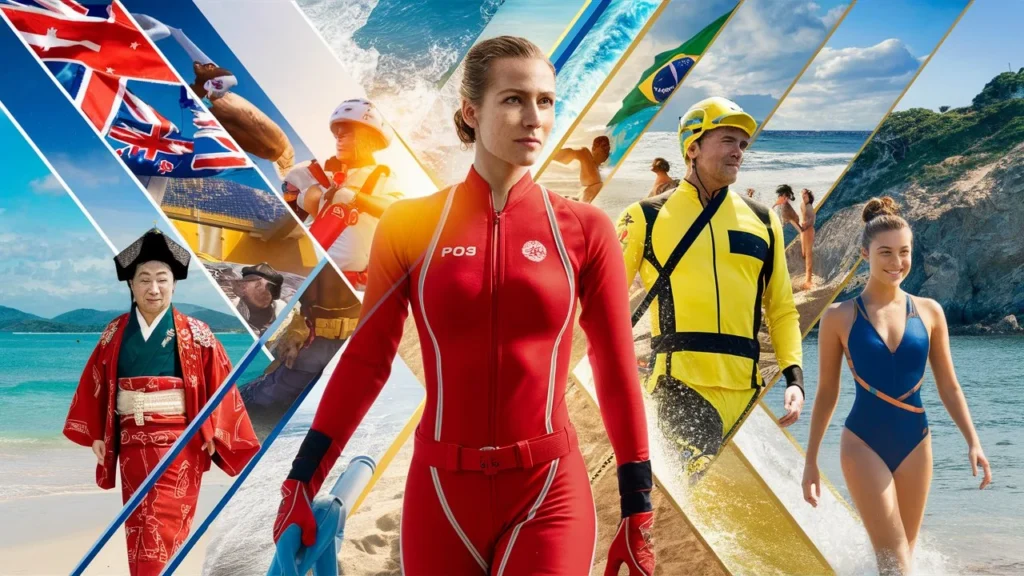
International Standards and Practices
While core principles are similar, variations exist in:
- Certification requirements across countries
- Rescue techniques favored in different regions
- Equipment standards and usage
Organizations like the International Life Saving Federation work to harmonize global practices.
Cultural Differences in Aquatic Safety
Cultural factors influence lifeguarding approaches:
- Attitudes towards water safety education
- Swimming abilities in different populations
- Gender roles in lifeguarding and aquatic activities
Adapting to these cultural nuances is crucial for effective lifeguarding worldwide.
Global Lifeguarding Organizations
Several international bodies shape lifeguarding:
- Royal Life Saving Society (Commonwealth countries)
- United States Lifesaving Association (USLA)
- Surf Life Saving Australia
These organizations often set benchmarks for training and operations.
Unique Challenges in Different Regions
Lifeguards face varied challenges globally:
- Rip currents in Australian beaches
- Crowded beaches in Mediterranean countries
- Remote locations in developing nations
Local knowledge and specialized training are often necessary.
International Exchange Programs
Many countries participate in:
- Lifeguard exchange programs
- International competitions and conferences
- Collaborative research on water safety
These initiatives promote the sharing of best practices and innovations.
Understanding global perspectives in lifeguarding enhances professional development and adaptability. It also highlights the universal importance of water safety, transcending geographical and cultural boundaries.
Tips for Aspiring Lifeguards
For those considering a career in lifeguarding, proper preparation is key to success. These tips can help aspiring lifeguards start their journey on the right foot.

Preparing for Certification
To get ready for lifeguard training:
- Improve swimming endurance with regular practice
- Work on treading water and underwater swimming skills
- Study basic water safety principles in advance
Early preparation increases the chances of passing certification tests.
Building Relevant Experience
Gain valuable experience by:
- Volunteering at local pools or beaches
- Participating in junior lifeguard programs
- Taking swimming lessons or joining a swim team
These activities build skills and demonstrate commitment to aquatic safety.
Developing Necessary Skills
Focus on improving:
- Physical fitness, especially cardiovascular endurance
- First aid and CPR skills through courses
- Communication abilities through public speaking practice
These skills are crucial for successful lifeguarding.
Finding Job Opportunities
Look for lifeguarding positions at:
- Community pools and recreation centers
- Water parks and theme parks
- Beaches and lakefront facilities
- Hotels and resorts with aquatic facilities
Networking with current lifeguards can also lead to job openings.
Aspiring lifeguards should approach the profession with dedication and a willingness to learn. The job demands physical fitness, mental alertness, and a strong sense of responsibility. By following these tips and maintaining a commitment to water safety, newcomers can set themselves up for a rewarding career in lifeguarding.
Remember, lifeguarding is more than just a job – it’s a crucial role in ensuring public safety and can be the starting point for a fulfilling career in aquatics or emergency
Conclusion
Lifeguarding is a crucial profession that combines physical prowess, mental alertness, and a commitment to public safety. This overview has shown that the role involves much more than just watching swimmers.
Key points to remember:
- Lifeguards need diverse skills, from swimming to emergency response
- The job requires ongoing learning and adaptation
- It offers various career paths and advancement opportunities
For those interested in this field, lifeguarding is both challenging and rewarding. It demands dedication and a genuine desire to help others. The skills gained can form a solid foundation for careers in aquatics, emergency services, or public safety.
As water activities grow more popular, lifeguards become increasingly vital. Their role in ensuring safety at pools, beaches, and water parks is indispensable. For aspiring lifeguards, this profession offers a chance to make a real difference in their communities, developing valuable skills while potentially saving lives.

Matthew Porter is the innovative mind behind Insuranted.com, a website dedicated to providing clear, comprehensive, and reliable information on insurance. With a passion for simplifying complex topics, Matthew aims to empower readers to make informed decisions about their insurance needs
